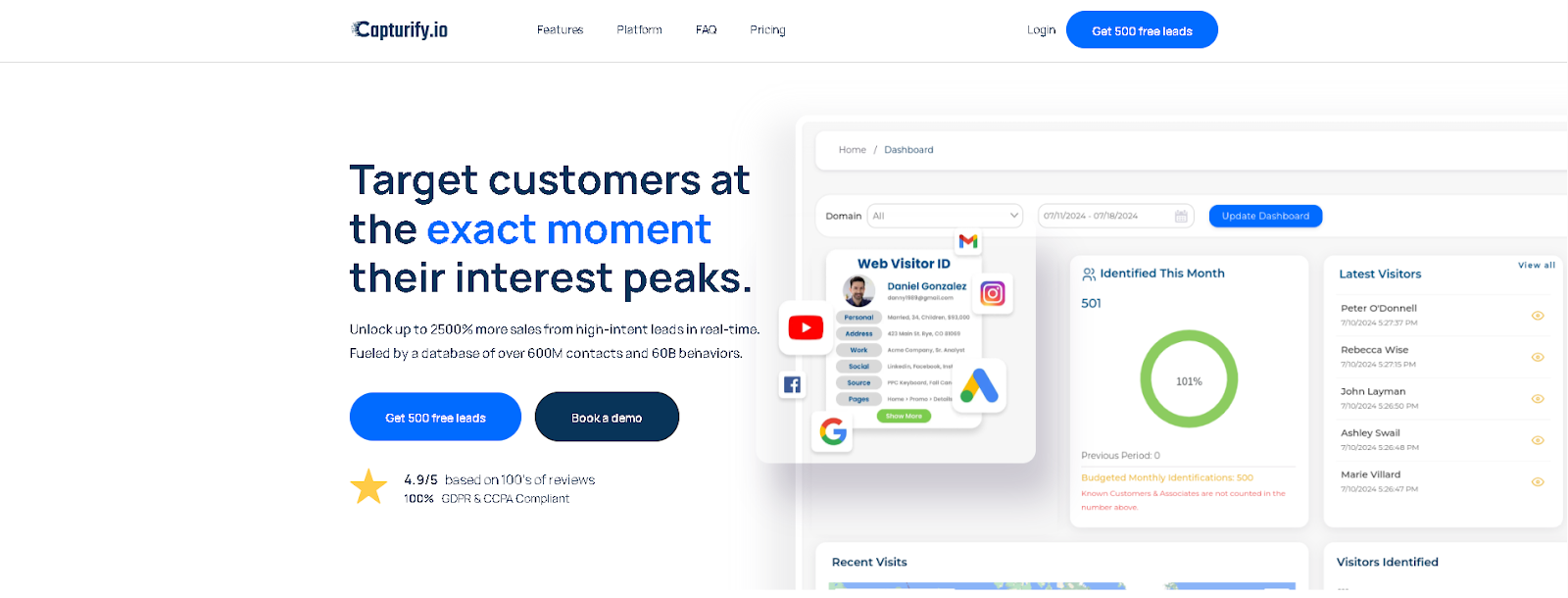Most marketing campaigns cast a wide net. But in modern business, that approach wastes time and budget.
Intent-based marketing flips the script. It uses real-time customer behavior, online interactions, and purchase intent signals to target people who are actively searching, researching, or comparing, not just browsing.
This shift is driven by intent data marketing, which helps marketing and sales teams focus on high-interest leads instead of guessing. By spotting buying intent early, brands like yours can deliver more relevant messages, improve conversion rates, and build stronger connections with potential customers.
Want to make it a core part of your strategy? This guide is for you.
What Is Intent and Intent Data?
At the heart of intent-based marketing is a simple idea: align your marketing efforts with what people actually want, right now.
To do that, you need to understand the different types of customer intent and intent data that shape the buying journey.
Types of Customer Intent
To make the most of your intent-based targeting, you need to recognize different intent levels:
- Informational intent: Early-stage research with no buying pressure.
- Passive intent: Mild engagement, like reading blogs or following on social.
- Active intent: Clear interest, such as product comparisons or demo requests.
- Transactional intent: Ready to buy. They are checking pricing or completing sign-up forms.
By aligning marketing messages with the right intent type, your marketing and sales teams can engage more efficiently, boost conversion rates, and create more meaningful connections with potential buyers.
Types of Intent Data
Intent data reveals what prospective customers are actively researching or considering online. It comes in two forms:
- First-party intent data: Collected from your own assets, such as site visits, email clicks, and product views.
- Third-party intent data: Behavior gathered from external websites, content hubs, and ad networks.
Sales and marketing teams use this data to spot buying intent early, personalize messaging, and guide high-potential leads through the sales process.
What Is Intent-Based Marketing?
Intent-based marketing is a strategy that targets leads based on their real-time behaviors, not broad demographics. Instead of assuming interest, it uses intent signals, like product page visits, keyword searches, and comparison activity, to identify where someone is in the buying process.
By analyzing this behavior, brands can match their marketing messages to what a prospect actually needs in the moment, whether they’re in the research phase or ready to purchase.
It’s a more precise marketing approach that helps sales and marketing teams improve relevance, reduce wasted spend, and drive better engagement. With it, you can deliver the right message to the right person at the right time.
Why Intent-Based Marketing Is Important
Intent-based marketing doesn’t just make you more efficient, but it also reflects how modern buyers behave.
Consumers no longer wait for ads. They search, compare, engage, and expect brands to keep up. Intent-based strategies make that possible.
It Creates Strategic Alignment
In many organizations, sales teams and marketing teams work from separate playbooks. Intent data changes that.
By grounding both functions in shared behavioral signals, your teams move from reactive to proactive. Marketing identifies target accounts early, sales engages when buying intent peaks, and everyone works from the same source of truth, not intuition.
It Prioritizes Buyer Readiness Over Volume
Traditional campaigns often measure success in leads captured. But not all leads are equal, or ready.
An intent-based marketing strategy focuses on lead quality, not just quantity. By identifying prospective customers showing strong online behavior, teams can shift focus from broad outreach to precision timing, which delivers marketing messages that reflect where someone is in their buying journey.
It Makes Data Actionable
Brands collect mountains of customer data, but most of it sits unused.
Intent marketing turns raw data into action. Whether it’s first-party intent data from your site or third-party intent signals from external platforms, this approach helps your marketing team understand which signals matter, when to act, and how to tailor content and ads for targeted marketing.
Done right, it’s not just about reaching customers. It’s about matching your message to their moment.
How Intent-Based Marketing Works: A Step-by-Step Framework
Implementing an intent-based marketing strategy isn’t about buying a list of keywords or retargeting every visitor. It’s about aligning your marketing and sales efforts with how people make decisions, using intent signals to guide every touchpoint.
Here’s how the process works from start to finish:
Step #1: Identify and Define Your Target Audience
Before you track intent, you need to know who you’re tracking.
Start by defining your target audience based on core customer data, such as firmographics, behaviors, pain points, and needs. For example, for business-to-business (B2B) brands, this might mean specific job roles or industries. On the other hand, for business-to-consumer (B2C) companies, it could be interest categories or product affinities.
This foundational step helps make sure your intent-based targeting stays focused on potential customers who are truly relevant, not just active online.
Step #2: Map the Buying Journey and Intent Stages
Every prospect enters the funnel with a different mindset. Some are casually exploring. Others are comparing products or are ready to buy.
Your job is to map that buying journey and define what informational, passive, active, and transactional intent look like in your context.
For example, informational intent could be reading blog posts on external websites, while passive intent is browsing your homepage or category pages. Active intent, for its part, could be visiting pricing or demo pages, and transactional intent might look like returning to the cart or requesting a quote.
Recognizing these layers allows for smarter segmentation and more tailored marketing messages.
Step #3: Collect and Classify Intent Data
Once intent stages are defined, it’s time to start collecting signals.
Use a combination of first-party intent data from pageviews, scroll depth, repeat visits, email clicks, and form fills, as well as third-party data, like content engagement on third-party platforms, tech research signals, and external website behavior.
Modern intent-based marketing tools and analytics platforms can help classify these signals and feed them into your marketing platforms and CRM systems.
This classification gives your sales and marketing teams a consistent framework for interpreting behavior and predicting purchase intent.
Step #4: Segment Based on Intent and Prioritize Target Accounts
Now that you’ve gathered data, organize leads into intent-based segments:
Send low intent into awareness or long-term re-engagement flows, nurture mid intent via email, social, or dynamic ads, and route high intent to your sales team.
Some teams layer in account-based marketing at this stage, especially in B2B, using intent marketing data to prioritize target accounts showing surging interest in relevant topics.
When you segment based on intent, you allocate your marketing budget more efficiently and align internal workflows for faster conversion.
Step #5: Personalize Campaigns to Match Intent
This is where intent-driven marketing comes to life.
Instead of sending the same generic content to everyone, build personalized experiences based on the intent signals each segment is showing.
A lead reading blog content? Show educational offers or guides. Someone comparing plans? Serve a case study or feature breakdown. Returning visitors with cart activity? Trigger a discount or urgency-driven call to action (CTA).
Personalization at the intent level increases engagement and conversion because your message doesn’t just appear randomly but resonates with the user.
Step #6: Sync With Sales for Timely Follow-Up
As soon as a prospective customer shows signs of active intent, your sales team needs to know.
Set up real-time alerts or lead scoring triggers in your CRM to route leads to the right sales professionals based on behavioral thresholds.
For example, someone who viewed your pricing page twice in 24 hours can be flagged for outbound, while someone who downloaded three guides and attended a webinar can be qualified as a warm lead.
This alignment makes sure sales teams strike while interest is high, not after it cools.
Step #7: Measure, Refine, and Repeat
Like any good marketing tactic, intent-based marketing requires iteration.
That means you need to track metrics like conversion rates by intent segment, average time from website visit to deal, response rates to marketing campaigns based on intent stage, and cost per lead per segment.
Use these insights to refine your content strategy, update your intent scoring model, and improve overall performance.
Most importantly, remember that intent signals change. What worked six months ago might not work now, and the best marketing and sales teams are the ones that adapt quickly.
Common Mistakes in Intent-Based Marketing
Even with the right tools, intent-based marketing can fall flat if the strategy isn’t implemented with care. Here are key missteps to avoid:
Treating All Intent the Same
Not all intent signals carry the same weight. A single blog view isn’t equal to multiple pricing page visits. Overvaluing weak signals leads to wasted marketing efforts and misaligned targeted advertising.
Instead, layer intent by stage and focus your marketing campaigns where buyer intent is strongest.
Ignoring First-Party Data
Many marketers chase third-party trends but overlook their own first-party data, like email opens, website traffic, or social media interactions. These are rich, real-time customer interactions that offer more context than external behavior alone.
Smart teams leverage intent data from both sources to gain insight and prioritize high-value target users.
Using Intent Without Context
Dumping leads into retargeting ads based solely on a visit or click? That’s not a strategy. It’s spam.
Intent without understanding the pain points or stage of the buying journey often leads to irrelevant outreach. Effective intent marketing means aligning targeted ads and messaging with clear, contextual signals.
Failing to Align Sales and Marketing
If your marketing strategy identifies high-intent leads, but your sales team isn’t ready to act, the opportunity is lost. Intent-based success depends on seamless coordination across shared tools, analytics dashboards, and KPIs that track both sides.
Don’t just run a marketing tactic. Build a connected, intent-driven marketing engine.
Make Intent Count With Capturify

To execute a high-performing intent-based marketing strategy, you need more than signals. You need clarity.
Capturify helps you unlock that clarity by turning anonymous website traffic into real leads. With real-time visibility into customer interactions, behavior, and technology usage, Capturify gives your marketing team the valuable insights needed to identify prospects and act faster.
Whether you're running account-based marketing, building smarter targeted ads, or aligning outreach with buyer intent, Capturify helps you make every signal count, so your marketing efforts are focused, efficient, and data-driven.
Ready to transform your intent-based approach into real results? Get 500 free leads with Capturify today.
FAQs About Intent-Based Marketing
What is intent-based marketing?
Intent-based marketing is a strategy that targets users based on real-time behavior and interest. By tracking intent signals like page views, keyword searches, and social media interactions, brands can tailor marketing campaigns to reach people showing buyer intent, not just passive interest.
What does intent mean in marketing?
In marketing, intent refers to the likelihood that a person will take a specific action, like buying, subscribing, or requesting a demo. Understanding intent helps teams use intent data to guide timing, messaging, and targeted advertising that speaks directly to a user’s needs.
What is an example of intent marketing?
If someone visits a pricing page three times in a week, that’s a sign of strong buyer intent. A brand could respond with a targeted ad, limited-time offer, or personalized email to move them toward conversion. That’s intent marketing in action.
What is intent-based targeting?
Intent-based targeting uses behavioral data and analytics tools to find and engage users actively researching topics related to your product or service. It allows marketers to identify prospects earlier and deliver messaging that reflects where they are in the buying journey, which can improve engagement and key performance indicators.






.avif)